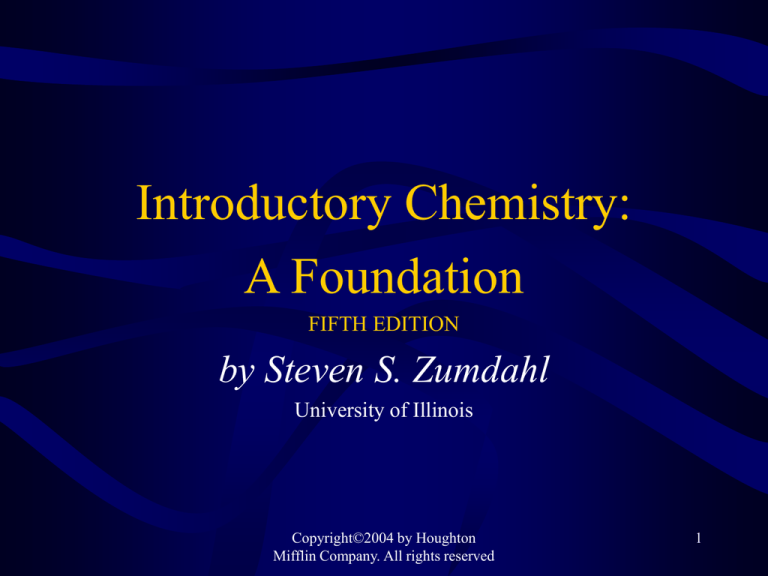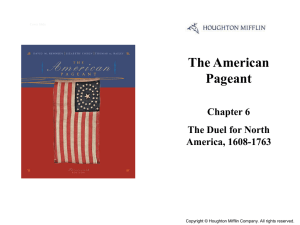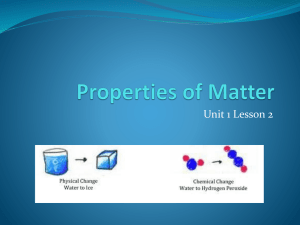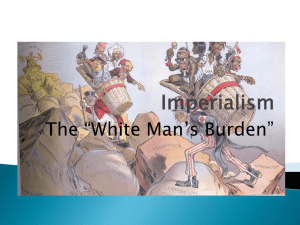
Introductory Chemistry:
A Foundation
FIFTH EDITION
by Steven S. Zumdahl
University of Illinois
Copyright©2004 by Houghton
Mifflin Company. All rights reserved
1
Measurements
and
Calculations
Chapter 2
Copyright©2004 by Houghton
Mifflin Company. All rights reserved
2
Measurement
• Quantitative Observation
• Comparison Based on an Accepted Scale
– e.g. Meter Stick
• Has 2 Parts – the Number and the Unit
– Number Tells Comparison
– Unit Tells Scale
Copyright©2004 by Houghton
Mifflin Company. All rights reserved
3
Scientific Notation
• Technique Used to Express Very Large or
Very Small Numbers
• Based on Powers of 10
• To Compare Numbers Written in Scientific
Notation
– First Compare Exponents of 10
– Then Compare Numbers
Copyright©2004 by Houghton
Mifflin Company. All rights reserved
4
Writing Numbers in Scientific Notation
1
2
Locate the Decimal Point
Move the decimal point to the right of the nonzero digit in the largest place
– The new number is now between 1 and 10
3
Multiply the new number by 10n
– where n is the number of places you moved the
decimal point
4
Determine the sign on the exponent n
– If the decimal point was moved left, n is +
– If the decimal point was moved right, n is –
– If the decimal point was not moved, n is 0
Copyright©2004 by Houghton
Mifflin Company. All rights reserved
5
Writing Numbers in Standard Form
1 Determine the sign of n of 10n
– If n is + the decimal point will move to the right
– If n is – the decimal point will move to the left
2 Determine the value of the exponent of 10
– Tells the number of places to move the decimal
point
3 Move the decimal point and rewrite the
number
Copyright©2004 by Houghton
Mifflin Company. All rights reserved
6
The Metric System
• All units in the metric system are related to
the fundamental unit by a power of 10
• The power of 10 is indicated by a prefix
• The prefixes are always the same,
regardless of the fundamental unit
Copyright©2004 by Houghton
Mifflin Company. All rights reserved
7
Prefixes in the Metric System
Copyright©2004 by Houghton
Mifflin Company. All rights reserved
8
SI (International System)-1960
Copyright©2004 by Houghton
Mifflin Company. All rights reserved
9
Length
• SI unit = meter (m)
– About 3½ inches longer than a yard
• Commonly use centimeters (cm)
– 1 m = 100 cm
– 1 cm = 0.01 m = 10 mm
– 1 inch = 2.54 cm (exactly)
Copyright©2004 by Houghton
Mifflin Company. All rights reserved
10
Length
Copyright©2004 by Houghton
Mifflin Company. All rights reserved
11
Volume
• Measure of the amount of three-dimensional space
occupied by a substance
• SI unit = cubic meter (m3)
• Commonly measure solid volume in cubic centimeters
(cm3)
– 1 m3 = 106 cm3
– 1 cm3 = 10-6 m3 = 0.000001 m3
• Commonly measure liquid or gas volume in milliliters
(mL)
–
–
–
–
1 L is slightly larger than 1 quart
1 L = 1 dL3 = 1000 mL = 103 mL
1 mL = 0.001 L = 10-3 L
1 mL = 1 cm3
Copyright©2004 by Houghton
Mifflin Company. All rights reserved
12
Volume
Copyright©2004 by Houghton
Mifflin Company. All rights reserved
13
Mass
• Measure of the amount of matter present in
an object
• SI unit = kilogram (kg)
• Commonly measure mass in grams (g) or
milligrams (mg)
– 1 kg = 2.2046 pounds, 1 lbs.. = 453.59 g
– 1 kg = 1000 g = 103 g, 1 g = 1000 mg = 103 mg
– 1 g = 0.001 kg = 10-3 kg, 1 mg = 0.001 g = 10-3 g
Copyright©2004 by Houghton
Mifflin Company. All rights reserved
14
Uncertainty in Measured Numbers
• A measurement always has some amount of
uncertainty
• Uncertainty comes from limitations of the
techniques used for comparison
• To understand how reliable a measurement
is, we need to understand the limitations of
the measurement
Copyright©2004 by Houghton
Mifflin Company. All rights reserved
15
Reporting Measurements
• To indicate the uncertainty of a single
measurement scientists use a system called
significant figures
• The last digit written in a measurement is
the number that is considered to be
uncertain
• Unless stated otherwise, the uncertainty in
the last digit is ±1
Copyright©2004 by Houghton
Mifflin Company. All rights reserved
16
Rules for Counting Significant Figures
• Nonzero integers are always significant
• Zeros
– Leading zeros never count as significant figures:
0.00085
– Captive zeros are always significant: 12.0085
– Trailing zeros are significant if the number has a
decimal point: 500. and 500
• Exact numbers have an unlimited number of
significant figures
Copyright©2004 by Houghton
Mifflin Company. All rights reserved
17
Rules for Rounding Off
• If the digit to be removed
• is less than 5, the preceding digit stays the
same
• is equal to or greater than 5, the preceding
digit is increased by 1
• In a series of calculations, carry the extra
digits to the final result and then round off
• Don’t forget to add place-holding zeros
if necessary to keep value the same!!
Copyright©2004 by Houghton
Mifflin Company. All rights reserved
18
Exact Numbers
• Exact Numbers are numbers known with certainty
• Unlimited number of significant figures
• They are either
– counting numbers
• number of sides on a square
– or defined
•
•
•
•
100 cm = 1 m, 12 in = 1 ft, 1 in = 2.54 cm
1 kg = 1000 g, 1 LB = 16 oz
1000 mL = 1 L; 1 gal = 4 qts.
1 minute = 60 seconds
Copyright©2004 by Houghton
Mifflin Company. All rights reserved
19
Calculations with Significant Figures
• Calculators/computers do not know
about significant figures!!!
• Exact numbers do not affect the number of
significant figures in an answer
• Answers to calculations must be rounded to
the proper number of significant figures
– round at the end of the calculation
Copyright©2004 by Houghton
Mifflin Company. All rights reserved
20
Multiplication/Division with
Significant Figures
•
•
•
Result has the same number of significant figures
as the measurement with the smallest number of
significant figures
Count the number of significant figures in each
measurement
Round the result so it has the same number of
significant figures as the measurement with the
smallest number of significant figures
4.5 cm
2 sig figs
x
0.200 cm =
3 sig figs
Copyright©2004 by Houghton
Mifflin Company. All rights reserved
0.90 cm2
2 sig figs
21
Adding/Subtracting Numbers
with Significant Figures
•
•
•
•
Result is limited by the number with the
smallest number of significant decimal places
Find last significant figure in each
measurement
Find which one is “left-most”
Round answer to the same decimal place
450 mL + 27.5 mL = 480 mL
precise to 10’s place
precise to 0.1’s place
Copyright©2004 by Houghton
Mifflin Company. All rights reserved
precise to 10’s place
22
Problem Solving and Dimensional Analysis
• Convert one unit of measurement to another
• Conversion factors are relationships between two units
– May be exact or measured
– Both parts of the conversion factor should have the same
number of significant figures
• Conversion factors generated from equivalence
statements
– e.g. 1 inch = 2.54 cm can give
or
2.54cm
1in
Copyright©2004 by Houghton
Mifflin Company. All rights reserved
1in
2.54cm
23
Problem Solving and Dimensional Analysis
• Arrange conversion factors so starting unit
cancels
– Arrange conversion factor so starting unit is on
the bottom of the conversion factor
3.45 cm = ? In
3.45 cm x 1in
2.54cm
Copyright©2004 by Houghton
Mifflin Company. All rights reserved
24
Converting One Unit to Another
•
•
•
Find the relationship(s) between the
starting and goal units. Write an
equivalence statement for each
relationship.
Write a conversion factor for each
equivalence statement.
Arrange the conversion factor(s) to cancel
starting unit and result in goal unit.
Copyright©2004 by Houghton
Mifflin Company. All rights reserved
25
Converting One Unit to Another
•
•
•
•
Check that the units cancel properly
Multiply and Divide the numbers to give
the answer with the proper unit.
Check your significant figures
Check that your answer makes sense!
Copyright©2004 by Houghton
Mifflin Company. All rights reserved
26
Temperature Scales
• Fahrenheit Scale, °F
– Water’s freezing point = 32°F, boiling point = 212°F
• Celsius Scale, °C
– Temperature unit larger than the Fahrenheit
– Water’s freezing point = 0°C, boiling point = 100°C
• Kelvin Scale, K
– Temperature unit same size as Celsius
– Water’s freezing point = 273 K, boiling point = 373 K
Copyright©2004 by Houghton
Mifflin Company. All rights reserved
27
Temperature Scales
Copyright©2004 by Houghton
Mifflin Company. All rights reserved
28
Temperature Conversions
• Kelvin to Celsius
T(k) = T(c) + 273
• Fahrenheit to
Celsius
T(f) = 1.80xT(c)+32
• Celsius to Fahrenheit
T(c) = (T(f) - 32)/1.80
Copyright©2004 by Houghton
Mifflin Company. All rights reserved
29
Density
• Density is a property of matter representing the mass per unit
volume
• For equal volumes, denser object has larger mass
• For equal masses, denser object has small volume
• Solids = g/cm3
– 1 cm3 = 1 mL
Mass
Density
• Liquids = g/mL
Volume
• Gases = g/L
• Volume of a solid can be determined by water displacement
• Density : solids > liquids >>> gases
• In a heterogeneous mixture, denser object sinks
Copyright©2004 by Houghton
Mifflin Company. All rights reserved
30
Using Density in Calculations
Mass
Density
Volume
Mass
Volume
Density
Mass Density Volume
Copyright©2004 by Houghton
Mifflin Company. All rights reserved
31







